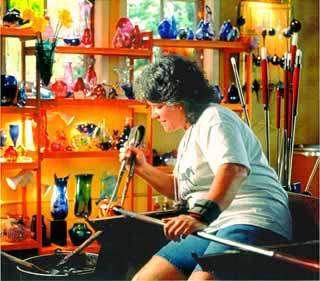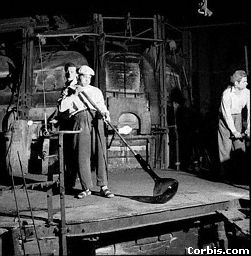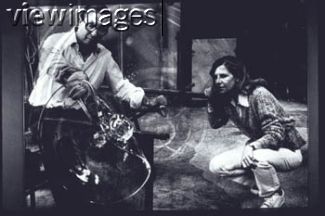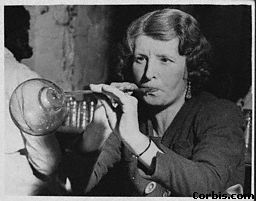Introduction

While I was researching a story on artistic glass blowing for Southeast
Ohio Magazine, I had trouble locating web sites with strong information.
With this site, I hope to bridge that gap, and provide an overview of the
art of glass blowing. This site contains numerous links to websites
containing information valuable to anyone interested in glass blowing.
Glass blowing is a traditional form of art, requiring patience, intution
and skill. Glass blowers spend years refining and developing their
skills through a trial and error process. Although there are many
schools, classes, and workshops throughout the world, glass blowing is
often taught as an apprenticeship, or by experimentation. It is an
art that takes an extremely temperate material and shapes it into delicate
and beautiful art.
"The beauty of glass is that you can create anything. You can
shape the glass into something totally life-like," says Jim Embrescia,
a glass artisan in Athens, Ohio.
Chapter 1: a brief History
of glass
Glass Online offers a brief History of glass from its discover in 5000
B.C. They document the origins of blowing glass to a Syrian craftsman
some time between 27 BC and AD 14. A long thin metal tube was used
to blow the glass into molds, surprisingly similar to the forms used today.
This site is valuable because it is a concise documentation of the history
of glass blowing.

Chapter 2: glass Production

This link is part of a lecture by Professor John
J. Mills of the Univeristy of Texas at Arlington. His Mechanical
and Aerospace Engineering Department offers Introduction to Manufacturing
Engineering (MSE 3344). This portion is taken from Professor Mills'
spring semester 2000 lecture. The course is designed to cover the
"broader aspects of manufacturing as well as details of individual processes
including casting, metal removal, environmentally conscious manufacturing
and finishing." The portion included is a scientific overview of
the processes of glass production, including many diagrams. Email
Professor John J. Mills.
Chapter 3: building
and maintaining a Hot
Glass Studio
Glass Notes
is a publication providing information for people who are interested in
owning or maintaining a hot glass studio. They claim to hold the
answers to technical questions, purchasing information, and a "mess of
other hot glass related information." They include a Dr. Glass hot
line for those questions not answered directly in the text. This site is
"a reference for the glass artist and the
only comprehensive reference written for studio glass artists, teachers,
and students, as well as anyone interested in the wonderful world of glass.
Internationally renown artist and glass educator, Henry Halem, explains
through easily understood words and drawings the intricacies of constructing
and maintaining the glass studio. Fifteen sections of hot glass information
include everything from furnaces, glory holes, and annealers to burners
and burner safety. But that's just for openers. There are sections on heat
flow, annealers and digital annealer controllers as well as were to buy
them. There is information from other experts in the field on other glass
related subjects. The pros and cons of brick versus fiber insulation is
discussed, as well as an overview on all types of refractory materials.
Glass studio safety is discussed at length. Exclusive, detailed information
on Klaus Moje's Kiln Casting is revealed along with Jose Chardiet's secrets
of sand casting. If you're in the dark about where to purchase glass-related
equipment and materials, the Vendors section at the back of the book is
for you. Not only does this resource list tell you where to buy glass-related
supplies but Halem also provides his own personal and often humorous commentary
on many of the products. There is so much more in this book that it is
impossible to list it all. Suffice it to say this book is for anyone that
has a desire to blow glass in his or her own studio."
Chapter 4: The
presence of
Women
in glass art
Glass blowing catches on with women
artists, is an article by Joy Hakanson Colby, a Detroit News Art Critic.
In her article, she highlights the life of Detroiter Theresa Pierzchala,
a career glass artist, maker and exhibitor of glass objects and one of
two women teaching hot glass at Detroit's Center for Creative Studies.
The article focuses on women artists in a field dominated by men.

Chapter 5: High
Schools blow glass into curriculum
There's art in the air as students blow glass is a story by Barbara
Brachtl as a Special to The Seattle Times. It features Bellevue school's
new glass-blowing studio - one of only two public-high-school glass studios
in the nation (the other is in Wisconsin).
Working with one or two assistants, each student drew a glob of molten
glass from a furnace, blew a hollow into it, worked it at a bench, reheated
it in a high-temperature gas oven when it began to harden and shaped it
further - and ultimately deposited it in a large oven known as an annealer
for a slow, controlled cool-down from 800 degrees. Hopefully, with
projects like these, glass blowing will be made available to people without
the contacts or resources to begin on their own. Also, highschool
students will be able to develop an appreciation and understanding of the
art of glass blowing.
Chapter 6:
video and instruction on blowing Glass
Ornaments

instruction
this site
includes a pictoral step-by-step process of blowing an ornament
Chapter
7: Links
to glass sites
There are 371 links on this page, relating to the following forms of
glass:
Lampworking / Flameworking, Glass Beads, Marbles, Paperweights,
Off-Hand Glassblowing, Hot Neon, Fused Glass, Scientific Glassblowers,
Supplier / Equipment, Stained Glass, Glass School, Glass Publication, Cold
Glass Working, GlassGalleries & Museum, Cast Glass.
Chapter 8:
illustrated glass
Dictionary
This link is
a large dictionary of terms relating to glass. It offers a search
engine of its resources to help guide you to the word you need.
Chapter
9: Suppliers
of machinery, materials, equiptment and plants
A yellow pages list of glass suppliers
of machinery, materials, equiptment and plants of art glass.




